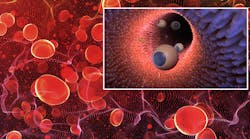Laser-Guided Microbots Track Down and Kill Tumors
Patients often suffer from diseases or illnesses that are out of reach to doctors. Sometimes the medicine can be made to track down the culprit to and eliminate it with no harm to the patient. Researchers at Caltech have adopted another approach. They use lasers to guide microrobots inside the body to deliver medicine directly to tumors deep inside the body.
“The microrobot concept is really cool because you can get micromachinery right to where you need it,” says Lihong Wang, a Caltech professor of medical and electrical engineering. “It could be drug delivery, or a predesigned microsurgery.”
The microrobots are microscopic spheres of magnesium metal almost completely coated with thin layers of gold and parylene, a polymer that resists digestion and prevents the patient’s body from destroying the microbots. The layers of gold leave a circular portion of the sphere uncovered. So, after the microbots are taken orally and are in the stomach, the magnesium inside react with the fluids in the digestive tract, generating small bubbles. The stream of bubbles acts like a jet and propels the sphere forward until it collides with nearby tissue.
On their own, the microrobots can zoom around, but they are not especially useful. To turn them from a novelty into a vehicle for delivering medication, Wang and Gao modified them.
First, a layer of medication is sandwiched between the magnesium and parylene coating. Then, to protect the microrobots from the harsh environment of the stomach, they are enveloped in microcapsules made of paraffin wax.
At this stage, the spheres can carry drugs, but still lack the crucial ability to deliver them to a desired location. For that, Wang and Gao use photoacoustic computed tomography (PACT), a technique developed by Wang that uses pulses of infrared laser light.
The infrared laser diffuses through tissues and is absorbed by oxygen-carrying hemoglobin molecules in red blood cells, making the molecules vibrate ultrasonically. Those ultrasonic vibrations are picked up by sensors pressed against the skin. Data from those sensors is used to create images of the internal structures of the body.
Previously, Wang has shown that versions of PACT can be used to identify breast tumors, or even individual cancer cells. With respect to the microrobots, PACT handle two tasks: imaging and tracking. PACT first lets healthcare technicians can find tumors in the digestive tract. It also lets them track the microrobots, which show up strongly in the PACT images.
Once the microrobots arrive near the tumor, a high-power, continuous-wave, near-infrared laser beam activates them. The microrobots absorb the infrared light so strongly, they briefly heat up, melting the wax capsule surrounding them and exposing the magnesium to digestive fluids. At that point, the microrobots’ bubble jets activate, and they begin swarming. The jets are not steerable, so the technique is sort of a shotgun approach. Not all the microrobots will hit the target, but many will. When they do, they stick to the surface and begin releasing their payloads of medication.
“These microbots can penetrate the mucus of the digestive tract and remain in place releasing medicine for a long time. This improves medicine delivery,” Gao says. “And because they’re magnesium, they’re biocompatible and biodegradable.”
Tests in animal models show that the microrobots perform as intended, but Gao and Wang say they are planning to continue pushing the research forward.
“We demonstrated the concept that you can reach the diseased area and activate the microrobots,” Gao says. “The next step is evaluating the therapeutic effect of them.”
Gao also says he would like to develop variations of the microrobots that operate in other parts of the body, and with different types of propulsion systems.
Wang says his goal is to improve how his PACT system interacts with the microrobots. The infrared laser light it uses has some difficulty reaching into deeper parts of the body, but he says it should be possible to develop a system that can penetrate further.

